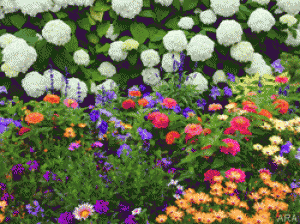No headline provided

February 1, 2011
Ever see a yard where mounds of beautiful, fabulous flowers –from perpetual poppies to luxurious lavender — filled everylandscaping bed in sight? Did you wonder how the gardener achievedsuch incredible results without going broke, buying flat after flatof flowers to populate his garden? How did he do it? One word:seeds.
Many homeowners and gardeners spend a bundle every year buyingflowers at their local home center or nursery, thinking they’retaking the quickest, easiest route to achieve a gorgeous garden.But planting flowers started by someone else has some drawbacks,like the lack of control over the quality and durability of theplants and the cost of the plants – which can either force you toskimp on the number of flowers you plant, or go over budget.
Every year, more gardeners discover that starting their ownplants from flower seedsis not only extremely economical, but satisfying and easier thanthey thought. You can choose from a multitude of flower seedvarieties to customize your garden exactly as you’d like it.Outsidepride.com offers a good variety of flower seeds, fromperennials to annuals, including wildflower seed choices. The seedexperts at Outsidepride.com offer a few tips for starting your ownflowers from seed this year:
* Start in early spring, depending on when the last expectedfrost date is for your area. If you’re starting seed indoors, checkyour seed packet to see how many weeks of growth are requiredbefore transplanting outdoors, and count back that many weeks fromyour last expected frost date.
* Starting seeds indoors is easy, enjoyable and can bebeneficial. It is the safer way to plant since you’re in control ofthe elements and you’ll get better germination. Maintainingseedlings indoors will take a bit more diligence since you can’trely on rain and sun to do the work for you.
* You might be tempted to start seeds indoors using soil fromyour garden. Use potting soil instead. It’s a better option becauseit contains peat, vermiculite and other fluffy matter that helpsthe soil retain water and drain well. It’s also free of diseasesand insects. It doesn’t have any nutrients, though, so you’ll needto add those.
* If your home has a room or windowsill that receives a full day(at least eight hours) of sunlight, you can start your seedlingsthere. Most gardeners will need to provide supplemental lightingfor seedlings to grow as strong and healthy as they would innatural sunlight.
You can also start wildflowerseed and flower seeds outside. After all risk of frost ispassed, rake a smooth soil surface for seeds. Remove rocks and clayclods, and comb the garden bed into a fine texture. Add compost andorganic supplements to the flower beds and dig them in to a depthof 6 to 8 inches. Water the bed thoroughly and allow it to drainfor at least 24 hours before planting.
You can mix small, fine seeds with sand to make it easier to getan even distribution of seed. Use the back of a spade to gentlypress fine seeds into the soil. Dig shallow trenches for largerseeds and hand place them as deep and far apart as is recommend onthe seed packet. For both sizes of seeds, make sure the coveringsoil is fine and porous enough for young seedlings to pushthrough.
Watering is always crucial. A fine hand-mister can prevent seedsfrom clumping together or washing away. Keep the soil evenlymoist.
From daisies and dahlias to peonies, petunias and poppies, it’spossible to start virtually any kind of flower from seed and getthat glorious garden you’ve always wanted and can easily afford. Toview flower seed varieties and learn more about starting flowersfrom seeds, visit www.outsidepride.com.






















Leave a Comment